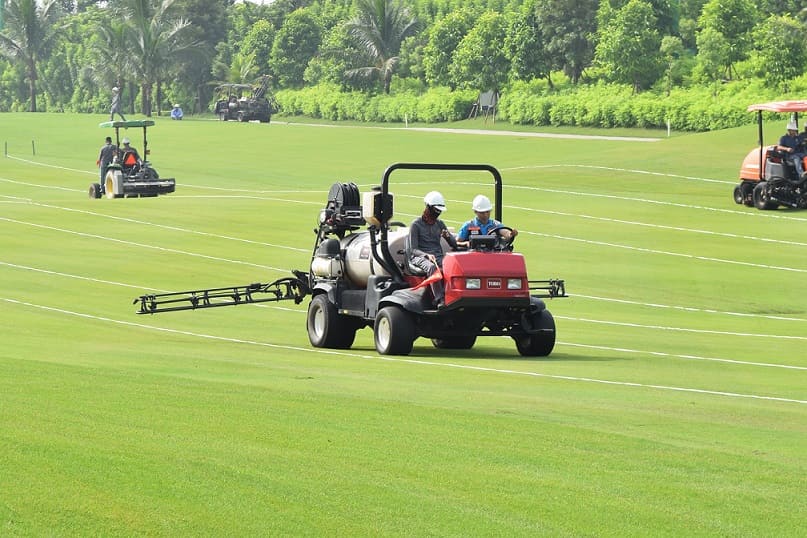Localities Need a More Responsible Approach to Attracting Golf Course Investments for Balanced and Sustainable Development
Golf Courses: A Driving Force for Local Socio-Economic Development
With beautiful landscapes and affordable service costs, golf courses in Vietnam are gradually becoming popular destinations for golfers worldwide, particularly tourists from South Korea and Japan. In 2019 and 2021, Vietnam was voted the World’s Best Golf Destination by the Golf World Awards and has been recognized as Asia’s Best Golf Destination for five consecutive years since 2017.
According to the Vietnam Golf Tourism Association, in the first seven months of 2023, approximately 1 million golf tourists visited Vietnam out of the 6.6 million international tourists. Before being heavily impacted by the COVID-19 pandemic, the golf tourism industry in Vietnam had generated nearly 5 trillion VND in annual revenue.
Recognizing this development trend, many provinces and cities have continued to incorporate golf courses into their planning under the new Planning Law No. 21/2017/QH14, viewing them as one of the key drivers of local socio-economic growth in the coming years.
Out of the 53 approved provincial plans and 10 currently under review, approximately 283 golf courses and 11 golf clusters are included in the approved plans, while 46 golf courses are listed in the provincial plans under assessment.
By 2050, Vietnam is expected to have around 400 newly planned golf courses (in addition to the existing 102 courses). When comparing this number of golf courses against the projected population of 108.5 million by 2049 (according to scenarios from the General Statistics Office and the United Nations Population Fund), the number of golf courses is still relatively modest compared to countries in the region, such as Japan or South Korea.
However, considering the potential impacts of golf courses on issues like environmental effects, land, and water resource usage, local leaders aiming to promote golf course development will need to carefully evaluate the quantity, location, and scale of these developments.
Vietnam Has Great Potential to Develop the Golf Industry – Illustrative Photo
Issues to Consider
Over a decade ago, when golf was just beginning to develop in Vietnam, various studies highlighted important issues to consider regarding land use, environmental impact, resources, and social aspects. In the coming years, with a significant number of golf courses planned for construction and operation, it is evident that thorough evaluations of the challenges posed by golf course development on all related socio-economic aspects will be necessary.
The first issue concerns the use of land resources for golf course development. According to the calculations of the American Society of Golf Course Architects, constructing a standard 18-hole golf course requires an average of 48 to 80 hectares of land, not including the additional area needed for auxiliary facilities or integrated real estate and commercial developments. Under current plans, many proposed golf courses are expected to utilize land areas ranging from 100 to 200 hectares to accommodate eco-resort villas, hotels, restaurants, and other facilities.
Although Decree No. 52/2020/ND-CP on “Investment in Construction and Business of Golf Courses” has detailed regulations in Articles 5 and 6 regarding site selection and land use requirements for golf courses—specifically, “The total area of a standard 18-hole golf course shall not exceed 90 hectares (an average of no more than 5 hectares per hole); the initial construction project for a golf course shall not exceed 270 hectares (54 holes)”—the use of hundreds of hectares of land still requires careful study and evaluation across economic, social, and environmental dimensions.
This is particularly important as there is a potential risk of investors using golf course projects as a pretext to integrate real estate developments such as resort villas, hotels, and restaurants. This could facilitate the project approval process or open opportunities for future land use conversions. Thus, local governments must implement strict management measures to prevent such occurrences.
Another critical concern is water resources and environmental impact, which must be carefully studied during the planning and construction stages of golf courses.
According to estimates by the United States Golf Association (USGA), a standard golf course in arid climates requires approximately 8,000 cubic meters of water daily—equivalent to the water consumption of 8,000 to 13,000 households. Therefore, constructing golf courses in areas with limited water resources could significantly affect water availability for production and domestic use. Poor management of water usage for golf course operations could also lead to unauthorized water exploitation, depletion of water resources, national resource losses, and even geological issues such as subsidence or landslides, posing risks to local livelihoods and production activities.
Additionally, environmental impact is another major concern, as golf courses require extensive use of chemicals to maintain grass surfaces. Therefore, it is essential to thoroughly assess environmental impacts when constructing golf courses in environmentally sensitive locations, such as near water sources, agricultural areas, or residential zones.

Solutions for Sustainable Development
Economic development is accompanied by an increased demand for communication, entertainment, relaxation, fitness, and healthcare. The development of golf courses is considered one of the appropriate solutions, as proven in many developed countries around the world.
However, the planning and development of golf courses, in terms of quantity and scale, should both create an economic growth engine for the localities and promote sustainable environmental development. This requires in-depth studies and evaluations right from the planning stage, including considerations for location, number, and scale of golf courses to be developed.
Some specific solutions that can be considered include:
- Strict Land Use Management
It is crucial to tightly manage land use for golf courses in accordance with Article 5 of Decree No. 52/2020/ND-CP on “Investment in Construction and Business of Golf Courses,” especially regarding the types of land that cannot be used for golf course development, and requirements for golf course development in mountainous or midland areas. Land use near or adjacent to heritage areas or sites of cultural significance should also be carefully considered. - Planning Based on Demand and Infrastructure
When developing the planning phase, it is necessary to calculate the appropriate number of golf courses based on the local demand from players, along with future player forecasts. Considerations such as service radius, travel distances, and the connectivity of transportation infrastructure must be examined to assess the feasibility of golf course development. An excessive number of golf courses in one area can lead to significant environmental impacts that may not be fully understood in the short term. - Control Over Real Estate Integration
It is essential to control proposals for golf course projects that involve blending real estate, tourism, or hotel business operations. Regulations should be put in place to ensure investors commit not to convert the golf course project into real estate development or other unrelated purposes, or to only allow such conversion if the golf business becomes unprofitable. - Water Resource Management
In addition to adhering to legal land use regulations, an accurate assessment of water resource needs for golf course development is necessary. This includes considering the total water consumption for golf courses alongside the needs for residential, agricultural, and industrial water use in the area. The assessment should be based on the existing water resource capacity and any changes due to climate change or future economic development. - Monitoring of Chemical and Fertilizer Use
It is important to strictly control the use of fertilizers and chemicals when operating golf courses. Regular monitoring and assessment of the environmental status—such as soil, water, air quality, and light—should be conducted at operational golf courses. This will help implement solutions to prevent or minimize environmental pollution impacts.
In recent years, the rapid growth of golf has served as evidence of economic growth as well as Vietnam’s ability to integrate into the global tourism market. With its favorable landscape conditions and open investment policies, more investors are likely to be attracted to golf course development, creating economic growth drivers at the local level and contributing to national development.
However, local authorities need a more responsible approach when attracting investment for golf course development, starting with the planning of golf course systems. This will ensure that golf development not only drives economic, cultural, and tourism growth but also ensures balanced and sustainable development goals.
Article by Dr. Han Minh Cuong, Chairman of the Board of S-Group Vietnam, published in Báo Đầu tư.






